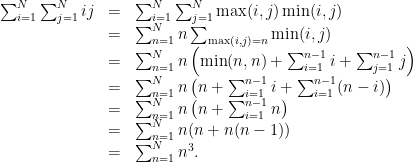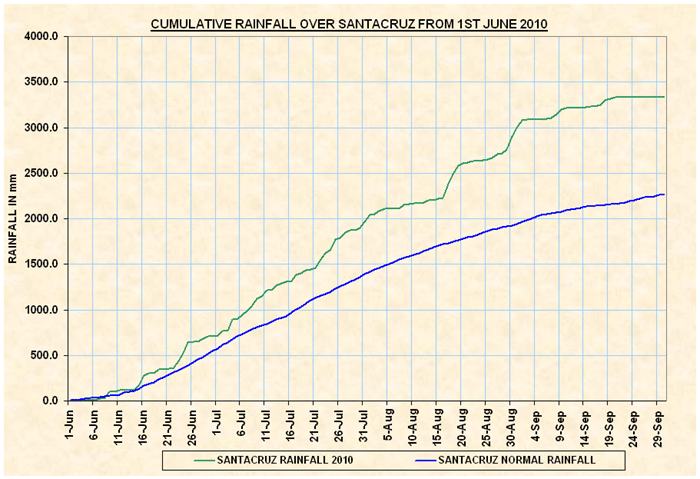This is the most elementary of my favourite formulas. I think I first saw this as a Year 8 student and have been enthralled by it ever since.

In words, the sum of the first N cubes is the square of the sum of the first N squares. Furthermore, both sides are equal to the square of the binomial coefficient  .
.
The formula was discovered by Aryabhata of Patna around 1500 years ago, but it may have been known before then. The most elementary proof is probably one by mathematical induction:
Let S be the set of positive integers N for which  . We wish to show that S is the set of all positive integers
. We wish to show that S is the set of all positive integers  . Firstly
. Firstly  since for N=1,
since for N=1,  . Assume
. Assume  . That is,
. That is,

For convenience denote by  the sum
the sum  . Then
. Then
![\begin{array}{lcl} \sum_{n=1}^{k+1} n^3 &=& (k+1)^3 + \sum_{n=1}^k n^3\\&=& (k+1)(k+1)^2 + T^2\quad \text{(by the inductive assumption)}\\ &=& T^2 + (k+1)[k(k+1) + (k+1)]\\&=&T^2 + (k+1)[2T + (k+1)]\\ &=& T^2 + 2T(k+1) + (k+1)^2\\&=& (T + (k + 1))^2\\ &=& \left(\sum_{n=1}^{k+1} n \right)^2.\end{array}](https://s0.wp.com/latex.php?latex=%5Cbegin%7Barray%7D%7Blcl%7D+%5Csum_%7Bn%3D1%7D%5E%7Bk%2B1%7D+n%5E3+%26%3D%26+%28k%2B1%29%5E3+%2B+%5Csum_%7Bn%3D1%7D%5Ek+n%5E3%5C%5C%26%3D%26+%28k%2B1%29%28k%2B1%29%5E2+%2B+T%5E2%5Cquad+%5Ctext%7B%28by+the+inductive+assumption%29%7D%5C%5C+%26%3D%26+T%5E2+%2B+%28k%2B1%29%5Bk%28k%2B1%29+%2B+%28k%2B1%29%5D%5C%5C%26%3D%26T%5E2+%2B+%28k%2B1%29%5B2T+%2B+%28k%2B1%29%5D%5C%5C+%26%3D%26+T%5E2+%2B+2T%28k%2B1%29+%2B+%28k%2B1%29%5E2%5C%5C%26%3D%26+%28T+%2B+%28k+%2B+1%29%29%5E2%5C%5C+%26%3D%26+%5Cleft%28%5Csum_%7Bn%3D1%7D%5E%7Bk%2B1%7D+n+%5Cright%29%5E2.%5Cend%7Barray%7D&bg=ffffff&fg=000000&s=0&c=20201002)
This shows that if  , then
, then  . Hence by the principle of mathematical induction,
. Hence by the principle of mathematical induction,  and we are done.
and we are done.
Next I will show the nicest proof that I am aware of (see p126 of [1] which also contains a proof by picture). We form the grid of numbers of the form  for i and j from 1 to N (as you would see in the multiplication tables) and sum the numbers of the grid in two ways. Below is an example for the case N=5.
for i and j from 1 to N (as you would see in the multiplication tables) and sum the numbers of the grid in two ways. Below is an example for the case N=5.
| 1 |
|
2 |
|
3 |
|
4 |
|
5 |
|
|
|
|
|
|
|
|
|
| 2 |
|
4 |
|
6 |
|
8 |
|
10 |
|
|
|
|
|
|
|
|
|
| 3 |
|
6 |
|
9 |
|
12 |
|
15 |
|
|
|
|
|
|
|
|
|
| 4 |
|
8 |
|
12 |
|
16 |
|
20 |
|
|
|
|
|
|
|
|
|
| 5 |
|
10 |
|
15 |
|
20 |
|
25 |
The easier sum is simply  the left side of the formula.
the left side of the formula.
Secondly, we sum along L-shapes, an example of which is shown in bold below.
| 1 |
|
2 |
|
3 |
|
4 |
|
5 |
|
|
|
|
|
|
|
|
|
| 2 |
|
4 |
|
6 |
|
8 |
|
10 |
|
|
|
|
|
|
|
|
|
| 3 |
|
6 |
|
9 |
|
12 |
|
15 |
|
|
|
|
|
|
|
|
|
| 4 |
|
8 |
|
12 |
|
16 |
|
20 |
|
|
|
|
|
|
|
|
|
| 5 |
|
10 |
|
15 |
|
20 |
|
25 |
Note that each number in such an L-shape is a multiple of max(i,j), which ranges from 1 to N. The sum of the numbers in an L-shape is then this multiple times the sum of 1, 2, …, max(i,j)-1, max(i,j), max(i,j) – 1, …, 2, 1, which can easily be shown to be  (think of counting the points of a square grid along diagonals). Hence the total is
(think of counting the points of a square grid along diagonals). Hence the total is
 .
.
In other words,

Reference:
[1] C. Alsina and R. Nelsen, “An Invitation to Proofs Without Words”, Eur. J. Pure Appl. Math, 3 (2010), 118-127, available here.




